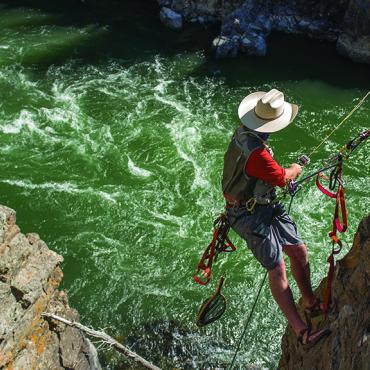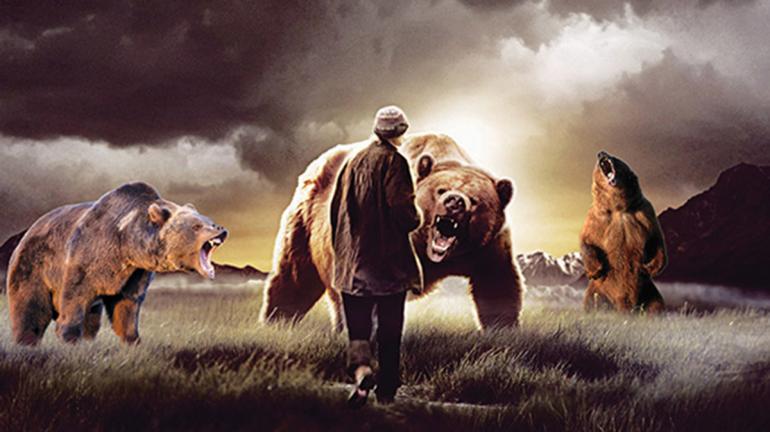Bruination
Beware of the bear pods.
Imagine, for a moment, that you’re walking through the woods on a popular hiking trail when you see a flash of fur, a blast of brown. A bear. A big one—a grizzly. It’s still 50 yards away, but it’s looking at you. Staring at you. Your pupils dilate, your muscles tighten, your heart rate soars—a textbook fight-or-flight response. You clutch the bear spray on your hip, and begin to slowly back away. And that’s when you see them: two other mature bears flanking you. Hunting you. The three bears close the distance quickly and efficiently, like wolves moving on an elk calf, and your last, panicked thoughts are confused: “Since when do bears hunt in packs?”
Sound far-fetched? It might have been, until claims of two veteran bear-watchers hold any water. As if there wasn’t enough to worry about in the woods, these two bear observers posit that grizzly bears have begun hunting cooperatively. As in: together. As in: groups of grizzlies rat-packin’ around like teenaged hoodlums at the mall. These visionary researchers are calling the small groups of bears pods, since the behavior is allegedly similar to orcas hunting the open sea—which is to say highly organized, highly social, and highly scary.
So far, the only reported casualties have been normal prey animals like elk and deer, but the idea of multiple grizzly bears teaming up to hunt is not to be taken lightly. It seems like something Steven King would come up with after dropping acid. Which means everyone might want to stay inside until we figure out what to do about this.
The behavior was first noticed in Yellowstone and Glacier parks, where bear density is high, and interactions with humans are numerous. Just as we’ve adapted different strategies of dealing with bears (i.e., discouraging habituation, relocating “problem” bears, and destroying repeat offenders), it seems bears may be taking a proactive role in their adaptations to deal with humans. Unaffiliated and unverified bear researchers Dr. Willie Gittmald and Dr. Betty Zofferoker say the cooperative behavior is “super trippy” and “terrifying as f*%k.”
Zofferoker and Gittmald, who declined to explain the nature or origin of their respective doctoral credentials, spend each summer living in a faded Toyota Sienna minivan, observing bears throughout Yellowstone and Glacier. You may have seen them, posted up next to their van in matching Vietnam-era camouflage jackets, staring through spotting scopes the size of Hubble telescopes, disgustedly waving tourists away like gnats. According to them, they are preeminent bear observers.
“No one watches bears more closely than us,” Gittmald explains. “We spend every waking moment fixated on these animals. It’s all we do.” A senior Yellowstone Park official (who declined to be named for this story) agrees: “Yeah, they watch bears an awful lot. It’s pretty bizarre, actually. It’s kind of disconcerting—and they’re real mean to the other Park visitors.” But this familiarity is what’s led Gittmald and Zofferoker to their hypothesis on cooperative bear behavior.
“We watched four mature grizzlies take down a cow elk last summer,” Gittmald explains. “They encircled it and just moved in all at once. It was intense, and unlike any normal bear behavior we’ve seen. They usually tend to avoid others of their kind—just like Zofferoker and me. It’s why we understand them so well.” Zofferoker confirms the account: “I was on some pretty heavy sedatives that day, but I’m pretty sure after they did the deed, those bears high-fived, man. How messed up is that? The bears are really going off the rails.” Acclaimed wildlife biologists in Glacier and Yellowstone declined to comment on this alleged revelation, but did scoff vehemently. One muttered something about conspiracy theories, which could be an important slip: could there be a government cover-up in progress?
The million-dollar question for recreationists in southwest Montana is simple: are bears hunting in pods? So far, there are two unreliable eyewitness accounts made by unaccredited experts working in tandem, who may or may not be homeless and are admittedly using drugs. According to Gittmald and Zofferoker, a Twitter confirmation is forthcoming, and will all but end the debate.
So, what should you do if confronted by a gang of aggressive grizzly bears? No one knows for sure. Traditional bear spray may deter them, but you may need several cans to mount an effective defense: four to six cans of bear spray worn bandolier-style over one shoulder should do the trick. Tripping or wounding your partner and leaving them for dead is always an option as well.
If bears are in fact hunting in small groups, the woods just got a little darker. But if not, hey, that’s awesome. Either way, stay alert, carry bear spray in the woods, and take everything you hear or read seriously—it’s all fact until proven otherwise.












